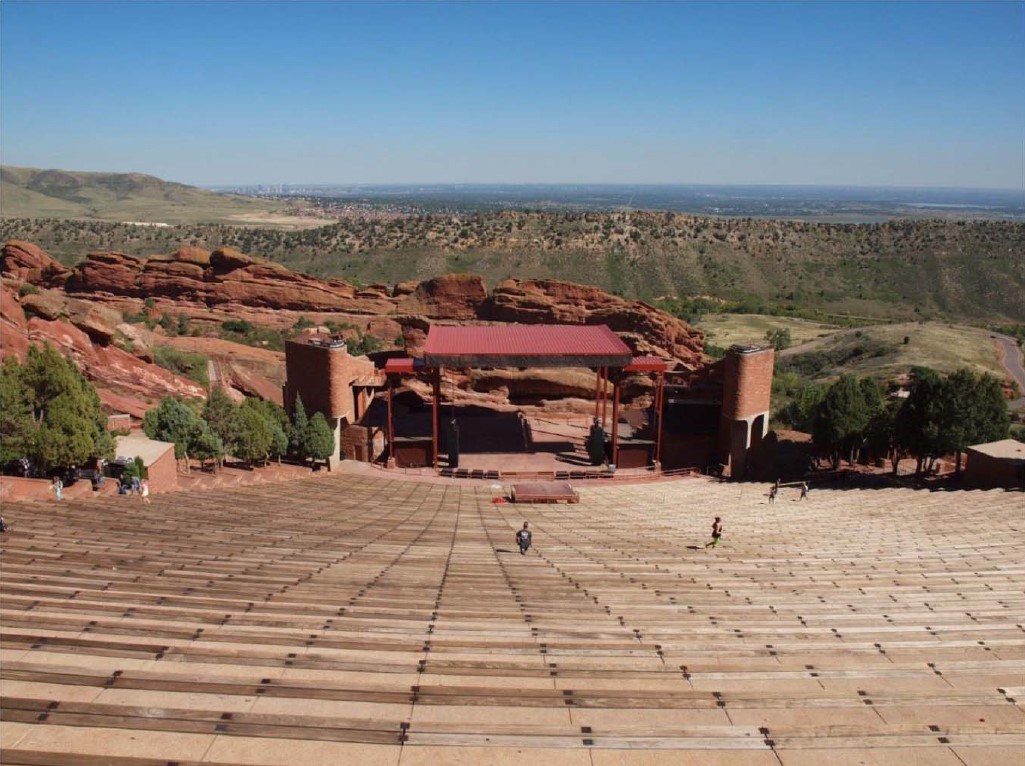Last updated: August 28, 2024
Article
Red Rocks Park and Mount Morrison Civilian Conservation Corps Camp

Photograph courtesy of Deon Wolfenbarger, National Historic Landmarks Program
In 1878, the area was first developed for visitors when John F. Gray and Leonard H. Eicholtz purchased the property that became the location of Red Rocks Park, which had been named the “Garden of the Angels” by its first recorded owner, Marion Burts. To encourage tourists to the site, Eicholtz worked with local residents to build roads, trails, and picnic grounds, as well as steps and ladders to help visitors climb the rocks. On October 10, 1905, Eicholtz sold 720 acres containing the core of the red rock formations to John Brisben Walker for $5,000.
In the 1910s, John Brisben Walker Sr. faced a series of setbacks, both financial and personal. Due to these setbacks, Walker began to sell portions of his Garden of the Titans, as Walker Jr. renamed the park. In 1927, Walker sold the 649 acres that comprised the central portion of the park to the Park of the Red Rocks Corporation, which subsequently sold the park lands to the City and County of Denver in 1928. Wasting no time, Denver officials made plans for constructing features within the park’s boundaries, as well as linkages to connect it to the larger mountain park system. In 1929, a large workforce utilized mule-drawn wagons, steam shovels, and dynamite to build a 5-mile roadway through the rock formations at the newly named “Park of the Red Rocks.”
President Roosevelt’s New Deal work relief programs provided the perfect vehicle for constructing Denver’s public projects. Using his political connections through Mayor Stapleton’s Democratic colleagues, George Cranmer, Denver’s Manager of Improvements and Parks, was able to obtain both Works Progress Administration (WPA) and CCC approval for work projects in Red Rocks Park. The CCC, beginning in 1935 was the key program used to develop several of the newly acquired mountain parks, including the monumental amphitheatre for Denver’s “Park of the Red Rocks,” as it was then called, an expenditure that would have otherwise seemed frivolous during the Depression.

Photograph courtesy of Deon Wolfenbarger, National Historic Landmarks Program
On June 30, 1935, a group of about 200 “junior” enrollees of Company 1848 that had been working in Durango, Colorado arrived by rail at Camp SP-13-C at Mount Morrison to engage in what historians today acknowledge as “one of the largest and most difficult projects undertaken by the Corps: the construction of Red Rocks theater.” While awaiting approval for the amphitheatre project, the enrollees also worked to improve the roadways and bankside sloping within Park of the Red Rocks. By November 1935, the CCC enrollees had completed improvements to several of the park’s road sections, along with the camp’s offices, a facilitating building, tool room, and repair garage. While these smaller projects were important, the proposed amphitheatre was at the forefront of the project planners’ minds. The NPS assistant regional officer, Mr. Alcott, visited the camp in early November for the sole purpose of reviewing the plans for the amphitheatre.
On May 9, 1936, almost one year after the CCC arrived for the project, Denver received approval from U.S. Secretary of the Interior Harold Ickes to use the CCC to build Red Rocks Amphitheatre, and the enrollees began work two days later with nearly all assigned to “Project No. 120”— the amphitheatre. The theater’s construction was also one of the largest CCC projects of its kind in the entire nation. It included an 80 x 170 foot stage, an orchestra pit large enough to hold an entire symphony, large dressing and control rooms, a huge tiered seating area for 10,000, a massive lighting system, and parking lots for over 4,000 automobiles. To accomplish this, the CCC enrollees removed 25,000 cubic yards of dirt, and used ten carloads of cement, 800 tons of quarried stone, and 90,000 square feet of flagstone in its construction. The 12,000 square feet of floor space made it the largest CCC project ever built.
The grand opening for Red Rocks Amphitheatre was held on June 15, 1941. The event included speeches from the Governor and Mayor and a concert by New York City’s Metropolitan Opera star soprano Helen Jepson. Today, the ampitheatre remains in use for events and the CCC camp facilities still remain. The City and County of Denver have been awarded a $750,000 grant from the Save America's Treasures program for repairs and rehabilitation of the mess hall/kitchen of the camp.
